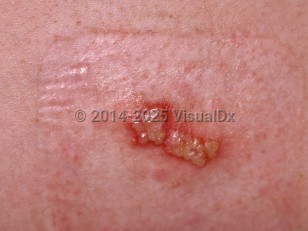HSV is highly contagious. It is spread by direct contact with virus-containing lesions or through contact with contaminated saliva or other body fluids during periods of viral shedding. The virus establishes lifelong latency in the dorsal root ganglia. Clinical disease occurs with reactivation (spontaneously or with trauma, UV exposure, fever, or immunosuppression) of the latent virus, which travels from the nerve root to innervated skin regions.
Primary infection denotes the initial inoculation episode, which may be subclinical or cause significant disease. Primary infections are more common in childhood. Symptoms of primary disease are usually more severe than recurrent disease and depend upon the site of inoculation.
- Orofacial herpes simplex infections (also known as cold sores, fever blisters, or herpetic gingivostomatitis) are very common viral infections causing pain, vesicles, ulceration, and crusting of the perioral skin and oral mucosa. The majority of primary infections are asymptomatic, occurring without any signs of cutaneous disease. Symptomatic eruptions may be highly localized to a small area or involve the entire oropharynx and lips. Severe oral ulcerations can develop and be associated with fever, pharyngitis, lymphadenopathy, malaise, headache, foul breath, and difficulty eating. The primary episode usually resolves within 14 days. However, viral shedding from intraoral lesions can persist for several weeks after clinical lesions have resolved.
- Genital herpes simplex is frequently seen in sexually active adolescents but can also occur in younger children. Symptoms develop within 5-10 days of initial contact. However, it is important to note that even when asymptomatic, a person sheds the virus and so can transmit the disease to another. In some adolescents, primary infection can be severe and include symptoms of aseptic meningitis such as fever, headache, stiff neck, and photophobia. In girls, there can be severe local symptoms of pain, dysuria, and vaginal discharge.
- Primary keratoconjunctivitis is associated with pain, eyelid edema, photophobia, and tearing. Localized adenopathy is common with primary infection. The disease occurs 3-7 days after exposure; recovery from a primary episode usually occurs in 2-6 weeks.
- Disseminated infection and pneumonitis may occur in the immunocompromised.
Recurrent disease describes reactivation episodes, which occur in 30%-50% of oral HSV and 95% of genital HSV infections. An individual may be coinfected with more than one type of HSV and in more than one location. HSV acquisition at a new site in a previously infected person is designated a nonprimary, first-episode infection.
Recurrent disease usually lacks constitutional symptoms. Itching, burning, or pain often precedes the skin lesions. Complications include bacterial superinfection, eczema herpeticum, erythema multiforme, Bell palsy, aseptic meningitis, and encephalitis.



 Patient Information for
Patient Information for 
